There’s some confusion as I sip coffee with Simon Denton.
“It’s not tapas,” he says sternly. “Don’t say that.”
We’re discussing the pending opening of his latest venture – Izakaya Den on Russell Street in the CBD – and I’m looking for the best way to describe the idea of an izakaya to anyone who hasn’t heard the expression before.
Never miss a Melbourne moment. Make sure you're subscribed to our newsletter today.
SUBSCRIBE NOW“While it’s obviously a good reference point, the izakaya idea is just as old [as tapas] and I think it’s unfair to say ‘it’s like this’… when it is its own thing,” Denton explains.
And he’s right. For a start the izakaya is a Japanese idea, rather than Spanish, and you’re unlikely to find any sherry on the menu. But that still doesn’t help me with a description, so we push on.
Pronounced ‘iz-ah-kye-ah’, it translates roughly as ‘sit down and have a drink’ – but it’s so much more than that. It’s like the perfect mix of a bar and restaurant: a fifty-fifty of great drinks and small plates of food, where you can relax with friends in a casual environment.
“There’re no hard and fast rules about what you should be serving,” says Denton. “You’ve got flexibility. But the izakaya is also about being a meeting place, as opposed to a formal restaurant.”
And in that moment, we’ve absolutely hit on it.
“They’re locals,” notes Denton of the izakaya’s typical clientele, adding that the izakayas themselves are “places that people will go to meet friends. It’s a bit free-form to the way people might do things [now], but they’ll always have a drink first, then order a few things, then have a few more drinks. It’s a very relaxed and ongoing process.”
Toshi Maeda, owner and self-taught sake master of Richmond’s Maedaya Sake & Grill, sees it much the same way.
“Izakaya is a place where you sit down at the end of the day and have a couple of drinks, sake or beer, and something easy to eat. Like a pub, with a little bit more food – a selection that always comes in small plates so you can try a few different ones, sharing with colleagues or friends,” he says, noting that common practice is to sit along a bar, but that seating arrangements vary.
Like this mixed seating, izakayas also have a mix of Japanese food, from sushi and yakitori skewers, to edamame, or strips of grilled wagyu. Individual Izakayas might favour particular items, such as the charcoal grill at Maedaya, but the key is that it needs to be fast service, making it casual and speedy food – “so you don’t have to sit around too much if you just want a couple of quick meals and a couple of drinks.”
But just because it can be quick, doesn’t mean you get rushed in and out. Being comfortable is another key factor in creating the right Izakaya atmosphere.
What Denton draws from his trips to Japan is that most people start off with a beer, “almost so that they can have a think about what they want to do. Then they’ll go on and order their sake, and maybe a couple of dishes. So there isn’t this thing of ordering all your dishes at once. And I guess we want people to be comfortable enough to try and do that,” he says.
And Maeda agrees, pointing out that once the ‘multiple dish’ idea is explained, most diners relax into it, realising that casual Izakaya dining doesn’t have to be a rushed affair.
Maeda also fosters the ‘comfortable local’ feel with the use of sake lockers, another Izakaya trademark. Lining the wall are locked perspex boxes, some with tagged sake bottles inside.
[pagebreak]
“If a customer orders a bottle of sake but can’t finish it in one night, they leave it in a sake locker and come back again in the next few weeks to finish it,” he explains. It’s like sake babysitting and encourages diners to become comfortable regulars.
But with all the local and casual dining available, why the sudden increase in izakayas in Melbourne?
“Melbourne diners want to understand nuances,” Denton says, “and people are getting used to eating like that. People are eating small plates now. I think that’s partly why Izakaya is coming in. People are better at understanding without too much explanation. It’s a change in the landscape.”
Maeda adds to this, pointing to a rising interest in sake, along with a lack of casual Japanese dining other than sushi bars.
“My original idea was to open an izakaya in Melbourne like [the one] where I go in Japan,” he says. “I couldn’t find anywhere similar, so I thought ‘ok I’ll open it myself’.”
He’s also pleased to see other new izakaya arrivals including Ichi Ni in St Kilda, Nihonshu in the city and now Izakaya Den.
“It’s good, because then I can go there to relax, and just enjoy it as an Izakaya customer.”
But now that we’ve taken the izakaya and transplanted it to Melbourne, can we expect an authentic experience?
“It’s not exactly the same here as with Japan,” says Maeda, “but that doesn’t matter; if you feel comfortable, that’s more important.”
Denton feels the same way, pointing out that advice from izakaya proprietors in Japan centered on reflecting your own location.
“I was told it’s important to remember that izakaya is also about where you are. Not to try and repeat what is being done in Tokyo… it’s important that it’s very Japanese, but it’s also important that it is representative of Melbourne and what people are like in Melbourne.”
So get ready for the shouts of ‘Irasshaimase!’ as you open the door. The izakaya has arrived in Melbourne. Kampai!



